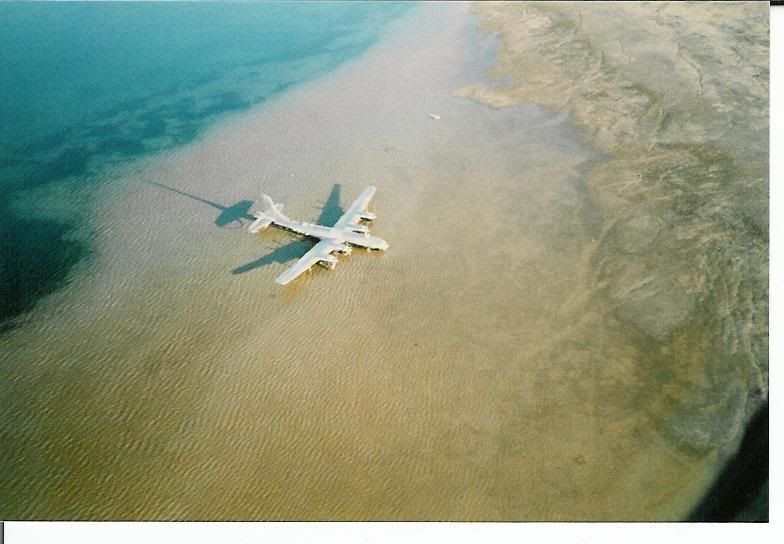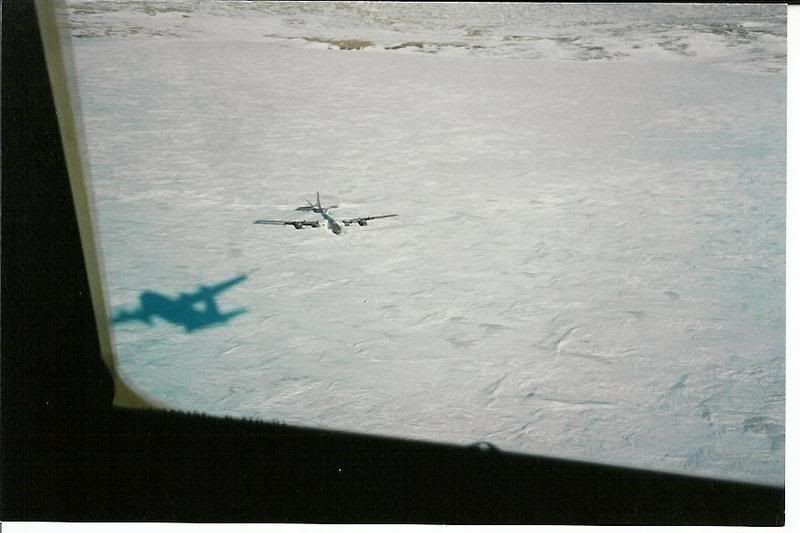B-29 documentary on TV??
Moderators: lilfssister, North Shore, sky's the limit, sepia, Sulako, I WAS Birddog
B-29 documentary on TV??
anyone saw tonight the documentary about the lost B-29(B-29 Frozen in Time on TVO) in Alaska and some volunteers trying to recover it and fly it out of there after being stuck there since WWII??
What a nice film, and a sad ending unfourtunatelly, but it was a great show on how people can make things work in some quite brutal conditions...anyways...if anyone has a link where I can see the whole thing I would appreciate it!
What a nice film, and a sad ending unfourtunatelly, but it was a great show on how people can make things work in some quite brutal conditions...anyways...if anyone has a link where I can see the whole thing I would appreciate it!
If it's the one I'm thinking of, it's called Flight of the Keybird. It was a PBS documentary from a few years ago of a B-29 in Northern Greenland. APU torn off and burnt the ole girl to the ground. Very interesting show.
It's better to break ground and head into the wind than to break wind and head into the ground.
-
linecrew
- Rank (9)

- Posts: 1900
- Joined: Fri Feb 20, 2004 6:53 am
- Location: On final so get off the damn runway!
The B-29 was called KEEBIRD. Here is the transcript of the NOVA documentary you saw. I can't watch it to the end...it just pisses me off too much.
http://www.pbs.org/wgbh/nova/transcripts/2303b29.html
http://www.pbs.org/wgbh/nova/transcripts/2303b29.html
Last edited by linecrew on Fri Dec 01, 2006 5:44 am, edited 1 time in total.
-
Idriveplane
- Rank 6

- Posts: 424
- Joined: Mon Sep 05, 2005 10:54 am
- Location: Tree tops
Excellent program. Unfortunatly this illustrates what happens when you have more dollars than sense. Really liked the ex-airline pilot who never flew off-strip or a Caribou before, then tried to do both. If they would only have waited for the snow to melt and drain, then that whole lake would have been nice and smooth, like a paved surface. Seems to me the wise arctic veteran that flew them up in the First Air twin otter suggested that, but they wouldn't listen, a real shame. A man lost his life up there, for what?
- Axial Flow
- Rank 7

- Posts: 507
- Joined: Wed Feb 25, 2004 6:00 pm
I thought with all the money and work that they did it would have seemed easier to take off wings, tail and wait till winter and fly it out piece by piece on a herc. I couldn't believe how much they accomplished working out there and with such a battered piece of equipment.
Axial Flow "I couldn't believe how much they accomplished working out there and with such a battered piece of equipment."
that was what I thought as well...I know the decisions they made there, directly affacted the outcome of the entire project, but you got to give these guys a credit to work in an enviroment like they had...under some pretty rough weather condtions.
that was what I thought as well...I know the decisions they made there, directly affacted the outcome of the entire project, but you got to give these guys a credit to work in an enviroment like they had...under some pretty rough weather condtions.
- Axial Flow
- Rank 7

- Posts: 507
- Joined: Wed Feb 25, 2004 6:00 pm
The first shot was taken during Operation "Boxtop" in 1988. The second was taken during Boxtop in 1990, along with this one. Darryl and the boys made their big mess in the summer of 1995. I'll hunt around for my pictures of what she looks like now. The whole top of the fuselage burnt away and she broke in half forward of the wing. She still looks like a B-29 but she looks like a burned one now! Darryl and the boys put 4 overhauled engines and props on her and were nice enough to pull the drain plugs so that they would fill with water when the lake melted in the spring. I guess he just didn't want anyone profitting from his work. Didn't seem to care too much about dropping all that oil into the environment or about leaving the place looking like a garbage dump when they left. Real pros those guys!Idriveplane wrote:Those are awesome pics when were they taken? What exactly happened to it?
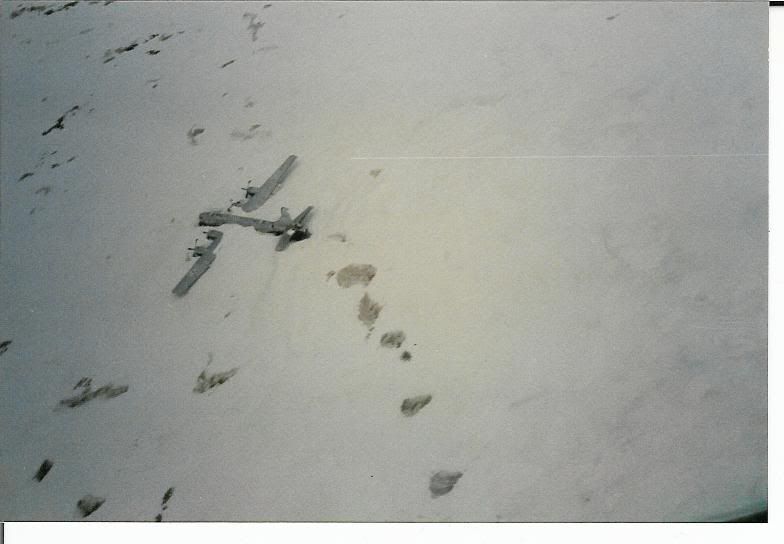
Last edited by Blakey on Sun Dec 03, 2006 7:57 am, edited 1 time in total.
Just because you're paranoid doesn't mean they're not after you!
-
Idriveplane
- Rank 6

- Posts: 424
- Joined: Mon Sep 05, 2005 10:54 am
- Location: Tree tops
You would have to build an ice runway for a Herc to land there or use a ski bird and there are no civilian ski birds. Lots of parts, such as wing panels and fuselage sections, would be too big for a Herc to carry. A Herc costs about $4000/hr for a civilian operator to operate; the military is more. It's just not economical to recover a plane at that cost. This plane was WAYYYYY up in northern Greenland. We used to imagine the best ways to get her out and the best idea I heard of was a very large balloon to the coast onto a barge when the wind was right!Idriveplane wrote:Man what a waste! Why did they not just dissassemble it and fly it out on some herc runs? And talk about throwing away 4 rare overhauled engines
Darryl would have had lots of trouble ahead of him even if he did get her airborne. I've heard lots of people speculate that the goal was not to recover her in the end. Watch the video of him taxiing! Just what did they need an APU running for on that flight anyway?
Last edited by Blakey on Sun Dec 10, 2006 2:57 pm, edited 1 time in total.
Just because you're paranoid doesn't mean they're not after you!
-
Lost in Saigon
- Rank 8

- Posts: 852
- Joined: Wed Jul 21, 2004 9:35 pm
The "APU" was a very small gasoline powered generator used to assist the
batteries during engine starts. All the Canso's I flew had them.
He probably just forgot to shut it down after he got the engines going.
FOUND ON THE WEB...............
My brother-in-law, Bob Vanderveen, was one of the few "lucky" people have
gone on that expedition and the 1995 one.
He nearly died in the tragic fire that consumed the B-29. Perhaps the one
item which saddened me the most about many of the posts was the reoccurring
theme that the expeditions were poorly planned. Nothing can be further from the truth.
They didn't just hop over to Greenland one day after having a cold one on the back
porch in California with the thought of simply dumping a bit of fuel into the Kee Bird,
kicking over the engines and flying the bird back to the States. Come on, just think a
moment about the logistics of the expeditions for just a moment. (By the way, I
don't purport to be an expert as to what happened during the trips nor am I a real
aviationenthusiast)
- They had to find, buy, rebuild and test four B-29 carbureted engines.
They did this work in Ramona, California many, many months before
the summer 1994 trip. Bob and a number of others spent many long
hours for months attending to those engines. Spare parts are not in
plentiful supply for B-29s.
- They had to build and scrounge up an incredible amount of parts,
supplies and tools to take back with them to Greenland, including a
crane, bulldozer, propellers, cables, tires, bomb-bay doors, food for
6-8 weeks...
- They had to plan with Thule Air Force Base to allow them use the base
for part of their operations.
- Only one barge per year goes between North American and Thule.
The four rebuild engines along with a lot of the other parts had to
get on it. This stuff had to get loaded on trucks and carted to the
east coast in time for the barge departure. This had to be done
months before they would get to Greenland in 1994.
- ...
It should go with out saying that this required a lot of planning on
Darryl Greenamyer's part.
As to the donation argument, even after all the press about the 1994
exhibition, they couldn't even find even one donor to give them the
necessary clothing for the much colder 1995 mission. Each member had
to buy their own equipment.
With that said, here's a little from what my brother-in-law told me
about the last mission. (It's been awhile since he told me this story,
so some of the info might not be completely accurate. Also, Bob hasn't
wanted to talk about it too much.)
Bob was one of the four people on the Kee Bird during its last run.
He was stationed in the rear of the plane. While the plane was moving
down the bumpy, icy runway on top of the frozen lake, a lot of dust
swelled up inside the plane and in the rear cabin from the years of
dirt that accumulated in every nook-and-cranny of the plane. He quickly
realized that he had forgotten to wear his goggles and decided to go to
the middle of the plane to search for them. That's when he discovered the
APU was on fire. When he went to get the goggles, he had to leave the
headset for the intercom to the cockpit in the rear cabin. Once
he saw the fire, he knew he had to alert Darryl, Al Hansen and Thad
Dulin in the cockpit. In a matter of seconds the already dust filled
rear part of the plane became densely filled with thick, black smoke.
Bob had to feel his way back to the rear cabin, scrounge around for the
headset and with what little breath he had left, yell FIRE into mic.
He then had to run back through the smoke, breathing in a number of lung
numbing mouthfuls of the acrid smoke, and tumble out through the bomb-bay
doors onto the harsh ice. Meanwhile, as Darryl, Hansen and Dulin were
scrambling to try to get out of the cockpit hatch, one of them discovered
that their quick-release seat buckles didn't want to release. Another was
quick enough to find a rod and helped to pry the buckle open. Within
moments after Bob popped out the plane, the tail fell off and a few more
moments later after the cockpit crew jumped to safety, the fuselage was
fully involved. The plane continued to burn for hours.
From what it sounds to me, fire extinguishers would have had no effect.
By the time Bob saw the fire, it was already far too advanced to do
anything. Perhaps if they had a firefighter, in full turnout gear and
wearing a SCBA in front of the APU, they might have had a chance...
From what I understand, nothing was worth salvaging after the fire.
My brother-in-law had nearly $10,000 worth of tools, gear and camera
equipment burn up on the plane. He was sleeping on board the plane at
night since his tent somehow didn't arrive in Greenland and so he had
everything in the plane. He completely volunteered on the exhibitions,
while my sister had to work double duty at their Ramona Cafe Restaurant
in Ramona, California while worrying about her husband's safety in
Greenland.
I hope this gives a bit more insight as to what happened during the Kee
Bird recovery mission and that being an armchair coach in a warm 70
degree home makes it easy to criticize the work of a few brave people
out in a desolate place a few hundred miles from the north pole and in
sub-zero degree weather trying to recover a 43-ton plane. Take it apart,
yeah right. I'm happy that there are still a few people willing to take on
incredible risks.
A few other things:
1. Darryl received permission from Denmark to extract the plane. It was
not there simply for the taking.
2. The location of the plane was well known. The B-29 was supposed to
have been destroyed right after the plane crash landed and its
crew rescued in 1947, but for some reason the orders were never
carried out. If they were, all of this would have been a mute point.
3. The Caribou wasn't chosen for its looks. It had to be able to
carry a large payload and land and take-off on a short (about 1500')
loose dirt/muddy runway.
4. The original engines, which are the late model, fuel-injected versions,
and removed during the 1994 effort, are (I believe) in California. So,
yes, something from the original bird is still around.
Regards,
Stefan Steiner
stefans@concentric.net (soon to be cancelled: ssteiner@netcom.com)
http://www.concentric.net/~stefans
batteries during engine starts. All the Canso's I flew had them.
He probably just forgot to shut it down after he got the engines going.
FOUND ON THE WEB...............
My brother-in-law, Bob Vanderveen, was one of the few "lucky" people have
gone on that expedition and the 1995 one.
He nearly died in the tragic fire that consumed the B-29. Perhaps the one
item which saddened me the most about many of the posts was the reoccurring
theme that the expeditions were poorly planned. Nothing can be further from the truth.
They didn't just hop over to Greenland one day after having a cold one on the back
porch in California with the thought of simply dumping a bit of fuel into the Kee Bird,
kicking over the engines and flying the bird back to the States. Come on, just think a
moment about the logistics of the expeditions for just a moment. (By the way, I
don't purport to be an expert as to what happened during the trips nor am I a real
aviationenthusiast)
- They had to find, buy, rebuild and test four B-29 carbureted engines.
They did this work in Ramona, California many, many months before
the summer 1994 trip. Bob and a number of others spent many long
hours for months attending to those engines. Spare parts are not in
plentiful supply for B-29s.
- They had to build and scrounge up an incredible amount of parts,
supplies and tools to take back with them to Greenland, including a
crane, bulldozer, propellers, cables, tires, bomb-bay doors, food for
6-8 weeks...
- They had to plan with Thule Air Force Base to allow them use the base
for part of their operations.
- Only one barge per year goes between North American and Thule.
The four rebuild engines along with a lot of the other parts had to
get on it. This stuff had to get loaded on trucks and carted to the
east coast in time for the barge departure. This had to be done
months before they would get to Greenland in 1994.
- ...
It should go with out saying that this required a lot of planning on
Darryl Greenamyer's part.
As to the donation argument, even after all the press about the 1994
exhibition, they couldn't even find even one donor to give them the
necessary clothing for the much colder 1995 mission. Each member had
to buy their own equipment.
With that said, here's a little from what my brother-in-law told me
about the last mission. (It's been awhile since he told me this story,
so some of the info might not be completely accurate. Also, Bob hasn't
wanted to talk about it too much.)
Bob was one of the four people on the Kee Bird during its last run.
He was stationed in the rear of the plane. While the plane was moving
down the bumpy, icy runway on top of the frozen lake, a lot of dust
swelled up inside the plane and in the rear cabin from the years of
dirt that accumulated in every nook-and-cranny of the plane. He quickly
realized that he had forgotten to wear his goggles and decided to go to
the middle of the plane to search for them. That's when he discovered the
APU was on fire. When he went to get the goggles, he had to leave the
headset for the intercom to the cockpit in the rear cabin. Once
he saw the fire, he knew he had to alert Darryl, Al Hansen and Thad
Dulin in the cockpit. In a matter of seconds the already dust filled
rear part of the plane became densely filled with thick, black smoke.
Bob had to feel his way back to the rear cabin, scrounge around for the
headset and with what little breath he had left, yell FIRE into mic.
He then had to run back through the smoke, breathing in a number of lung
numbing mouthfuls of the acrid smoke, and tumble out through the bomb-bay
doors onto the harsh ice. Meanwhile, as Darryl, Hansen and Dulin were
scrambling to try to get out of the cockpit hatch, one of them discovered
that their quick-release seat buckles didn't want to release. Another was
quick enough to find a rod and helped to pry the buckle open. Within
moments after Bob popped out the plane, the tail fell off and a few more
moments later after the cockpit crew jumped to safety, the fuselage was
fully involved. The plane continued to burn for hours.
From what it sounds to me, fire extinguishers would have had no effect.
By the time Bob saw the fire, it was already far too advanced to do
anything. Perhaps if they had a firefighter, in full turnout gear and
wearing a SCBA in front of the APU, they might have had a chance...
From what I understand, nothing was worth salvaging after the fire.
My brother-in-law had nearly $10,000 worth of tools, gear and camera
equipment burn up on the plane. He was sleeping on board the plane at
night since his tent somehow didn't arrive in Greenland and so he had
everything in the plane. He completely volunteered on the exhibitions,
while my sister had to work double duty at their Ramona Cafe Restaurant
in Ramona, California while worrying about her husband's safety in
Greenland.
I hope this gives a bit more insight as to what happened during the Kee
Bird recovery mission and that being an armchair coach in a warm 70
degree home makes it easy to criticize the work of a few brave people
out in a desolate place a few hundred miles from the north pole and in
sub-zero degree weather trying to recover a 43-ton plane. Take it apart,
yeah right. I'm happy that there are still a few people willing to take on
incredible risks.
A few other things:
1. Darryl received permission from Denmark to extract the plane. It was
not there simply for the taking.
2. The location of the plane was well known. The B-29 was supposed to
have been destroyed right after the plane crash landed and its
crew rescued in 1947, but for some reason the orders were never
carried out. If they were, all of this would have been a mute point.
3. The Caribou wasn't chosen for its looks. It had to be able to
carry a large payload and land and take-off on a short (about 1500')
loose dirt/muddy runway.
4. The original engines, which are the late model, fuel-injected versions,
and removed during the 1994 effort, are (I believe) in California. So,
yes, something from the original bird is still around.
Regards,
Stefan Steiner
stefans@concentric.net (soon to be cancelled: ssteiner@netcom.com)
http://www.concentric.net/~stefans
-
Alex YCV
- Rank 4

- Posts: 281
- Joined: Sat Nov 18, 2006 6:41 pm
- Location: The old Cartierville Airport
- Contact:
Saigon, it's a lovely story and all, but the reality is that this whole project should have been done over a longer time frame... trying to rush the thing to happen in a short time before the end of the season was pushing it, and the point where the bird got roasted was just about "last chance" for that year.
They could more easily of come up one year and repaired all the other issues and covered the plane up to protect it over the next winter, and come back to install the engines and have a nice long period to check everything and make sure it worked out.
You can't replace planes like that, once they burn history goes with them
They could more easily of come up one year and repaired all the other issues and covered the plane up to protect it over the next winter, and come back to install the engines and have a nice long period to check everything and make sure it worked out.
You can't replace planes like that, once they burn history goes with them
This is a my sig... I hope you like it.
- Siddley Hawker
- Rank 11

- Posts: 3353
- Joined: Tue Aug 10, 2004 6:56 pm
- Location: 50.13N 66.17W
read the book, they brought DG in and he kind of took over, the plan originally was to drag the a/c to the coast and barge it out. DG never properly completed the paperwork, and the original guy had to clean up his mess. and yes the apu gas system was jury rigged because the original fuel pump was buggered the apu wasn't shutdown, and during his taxi trials the jug came loose the rest is history
You could never drag it to the coast. Attached is a Google Earth shot of Northern Greenland. The Kane Basin is in the center of the shot and, further up the coast, you can see the Peterman Fiord. Follow the fiord up to the ice cap and you'll see a funnel shaped lake joining the fiord from the south.rigpiggy wrote:read the book, they brought DG in and he kind of took over, the plan originally was to drag the a/c to the coast and barge it out. DG never properly completed the paperwork, and the original guy had to clean up his mess. and yes the apu gas system was jury rigged because the original fuel pump was buggered the apu wasn't shutdown, and during his taxi trials the jug came loose the rest is history
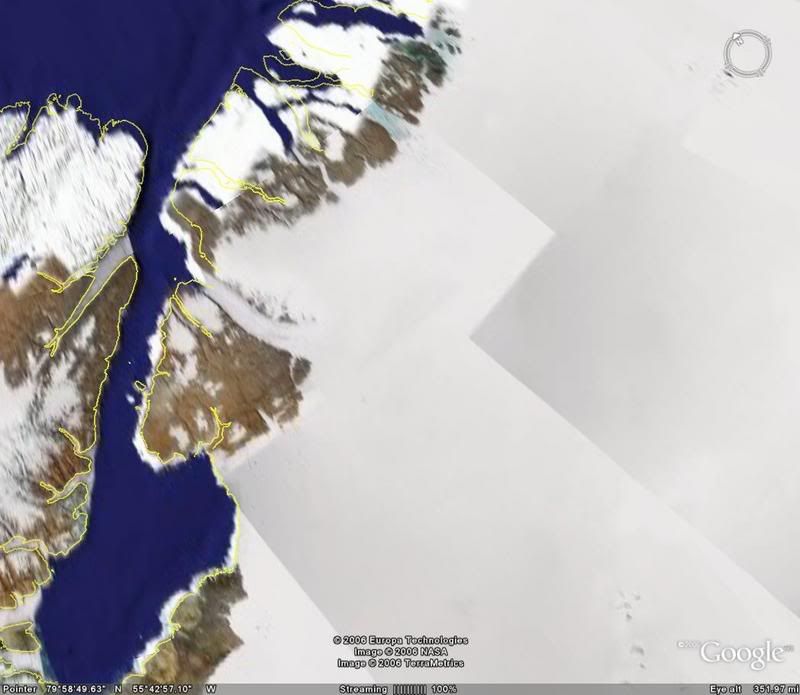
The Kee Bird is on the shore of a smaller lake just to the West of this. The second shot shows the lake close up. You can't see her in the shot but you can see where they landed the Caribou on the south shore of the lake. Have a look at the topography and the distance to the coast.
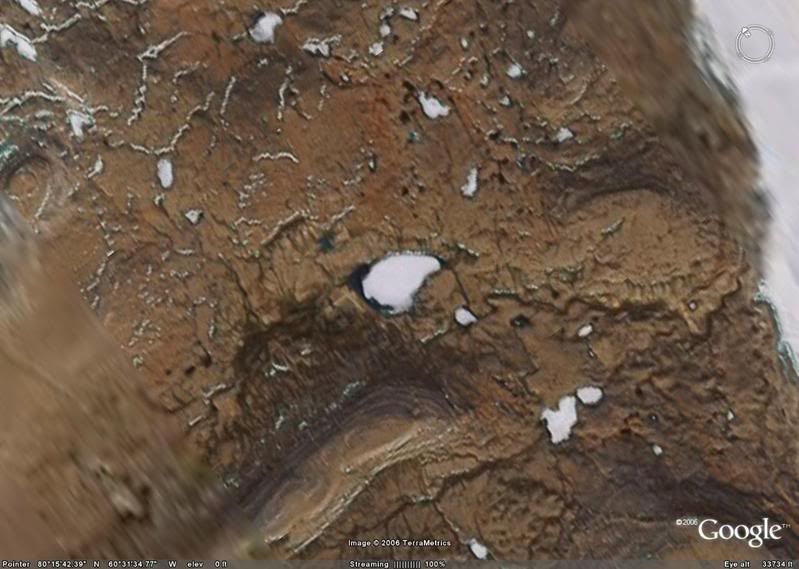
Just because you're paranoid doesn't mean they're not after you!
Some neat pics of the Kee-Bird and the "Boo" that supported the expedition.
http://www.dhc4and5.org/N124DG.html
http://www.dhc4and5.org/N124DG.html
Gravity always wins
-
Alex YCV
- Rank 4

- Posts: 281
- Joined: Sat Nov 18, 2006 6:41 pm
- Location: The old Cartierville Airport
- Contact:
Proof to me that they were way too much in a hurry. When things aren't working, slow down and work them out.Finally after two years of work they are ready for the flight back to Thule. The plane has frozen into the mud and snow, and it takes maximum power to break the wheels free. The nose wheel can't be controlled, and at slow speeds, Darryl has to adjust the engine power to steer the plane. Finally, it is moving in a wide circle, out onto the lake, on its way toward the end of the runway. The plane is bounced and shaken by the frozen snowdrifts. Suddenly, smoke can be seen pouring from the windows in the cockpit. The auxiliary power unit, a stand-by generator, was thrown from its mounting in the rear fuselage, and caught fire.
This is a my sig... I hope you like it.
-
Tracy Terry
- Rank 0

- Posts: 1
- Joined: Mon Oct 13, 2008 1:30 pm
Re: B-29 documentary on TV??
Darryl Greenamyer made a valiant effort to save that beautiful B-29 KeeBird, but sometimes things don't work out. It is so easy for people to play Monday morning quarterback about these things - if Darryl was successful, everyone would call him a hero.
Darryl is a great pilot and engineer and he is more than qualified to attempt such an endeavor. I am sorry it didn't work out and sorry for engineer Rick Kriege's death - he was another good man.
Darryl remains one of my favorite pilots and he is a credit to American aviation.
Darryl is a great pilot and engineer and he is more than qualified to attempt such an endeavor. I am sorry it didn't work out and sorry for engineer Rick Kriege's death - he was another good man.
Darryl remains one of my favorite pilots and he is a credit to American aviation.
-
Matthew L. Capitano
- Rank 0

- Posts: 2
- Joined: Tue Oct 14, 2008 7:49 pm
Re: B-29 documentary on TV??
Darryl Greenamyer is a great pilot and he tried very hard to bring back the B-29 'KeeBird' from NW Greenland.
Darryl and the other qualified men on the expedition such as Rick Kriege, Vernon Rich, and Cecilio Grande, did a super job of preparing the KeeBird for its first flight in close to 50 years.
There are so many variables involved in a venture like this - I'm sure I do not realize how much planning and field work really went into it - that there could be a hundred things that might go wrong.
Darryl did a super job of getting the plane ready and he was the man to fly that great plane out of that far away and harsh environment and back to Thule AFB and the rest of the world.
It's extremely regrettable that Darryl's competent engineer - and good man - Rick Kriege died due to internal physical sickness, and regrettable that the KeeBird caught fire and could not be fully recovered, but this salvage expedition was a triumph of American spirit, knowledge, and bravery.
Darryl Greenamyer is a great aviator and it took a long time for someone to decide to attempt to bring back the KeeBird, a fine plane that it seems many others ignored for so long.
My hat is off to Darryl, his recovery crew, and the brave men who flew on the KeeBird when it was in service long ago.
Darryl and the other qualified men on the expedition such as Rick Kriege, Vernon Rich, and Cecilio Grande, did a super job of preparing the KeeBird for its first flight in close to 50 years.
There are so many variables involved in a venture like this - I'm sure I do not realize how much planning and field work really went into it - that there could be a hundred things that might go wrong.
Darryl did a super job of getting the plane ready and he was the man to fly that great plane out of that far away and harsh environment and back to Thule AFB and the rest of the world.
It's extremely regrettable that Darryl's competent engineer - and good man - Rick Kriege died due to internal physical sickness, and regrettable that the KeeBird caught fire and could not be fully recovered, but this salvage expedition was a triumph of American spirit, knowledge, and bravery.
Darryl Greenamyer is a great aviator and it took a long time for someone to decide to attempt to bring back the KeeBird, a fine plane that it seems many others ignored for so long.
My hat is off to Darryl, his recovery crew, and the brave men who flew on the KeeBird when it was in service long ago.
